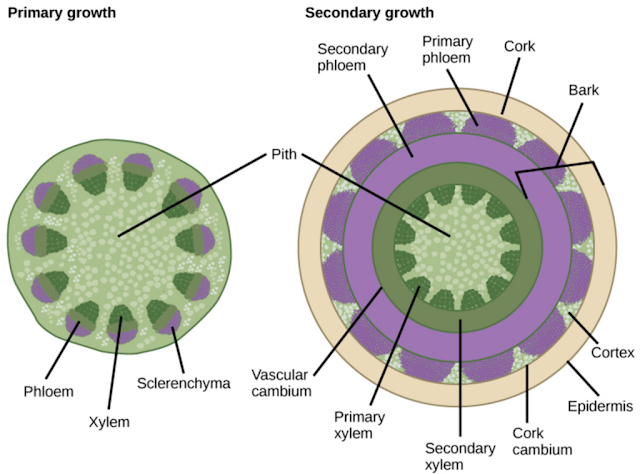Welcome to MBC Biology!
Here, I am posting a concise description of the secondary growth in dicot stem.
 |
| Schematic diagram of primary and secondary growth in dicot stem Image source: https://commons.m.wikimedia.org/wiki/File:Crescita_primaria_e_secondaria_del_fusto.png#file |
The process of formation of extra layers or secondary tissues due to activity of vascular cambium and cork cambium for increasing girth or thickness or diameter of plant is called secondary growth. It takes place in stellar regions due to the activity of vascular cambium (see Figure 17) and in extra-stellar regions due to the activity of cork cambium (see Figure 21).
Secondary growth in stellar regions due to the activity
of vascular cambium
Secondary growth due to activity of vascular cambium takes
place by the formation of cambium ring, formation of secondary
tissues, formation of annual rings or growth rings, and formation
of heartwood and sapwood.
Formation of cambium ring
The dicot stem has a strip of cambium in between xylem and
phloem in vascular bundles. This cambium is known as intrafascicular cambium.
During secondary growth, some cells of medullary rays that are present at the
level of intrafascicular cambium show meristematic activity to form the cambium
between two adjacent vascular bundles, called interfascicular cambium.
Intrafascicular cambium and interfascicular cambium join to form a cambium
ring.
Formation of secondary tissues
Cambium ring acts as a meristem to add the secondary tissues
both towards inner side and outer side. Cambium ring has two types of cells –
elongated spindle-shaped fusiform initials and short isodiametric
ray initials (see Figure 18). Fusiform initials divide to
form secondary phloem towards outer side and secondary xylem towards inner side.
The primary phloem and primary xylem are pushed towards periphery and centre by
secondary phloem and secondary xylem, respectively. Ray initials divide to form
vascular rays or secondary medullary rays on both sides. The activity of
fusiform initials is more than the activity of ray initials. So, more secondary
vascular tissues are formed than secondary medullary rays. In such condition,
secondary medullary rays are compressed by secondary vascular tissues and form
vascular rays. Vascular rays are uniseriate (one cell in breadth) or
multiseriate (two or more cells in breadth). Vascular rays present in between
the secondary xylem are called wood or xylem rays while the part
of rays present in between secondary phloem are called phloem rays (see Figure 19).
Formation of annual ring or growth ring
The activity of cambium ring in temperate region is not
uniform in spring or rainy season (favourable condition) and in cold winter or
dry hot summer (unfavourable condition). Cambium ring is more active during
favourable condition and form wide vessels containing more secondary xylem,
called spring wood (early wood). But during unfavourable
condition, a few small vessels containing secondary xylem, called autumn
wood (late wood), are formed. These two kinds of wood appear
together as a concentric ring in a year, called annual ring or growth
ring. Such rings are formed year after year. Such type of annual ring is
called ring porous wood.
The vessels in secondary xylem of the trees of tropical region
are almost similar in both the spring wood and autumn wood due to the uniform
activity of cambium ring in spring and autumn season. Such type of annual ring
is called diffuse porous wood.
Formation of heartwood and sapwood
In old trees, secondary xylem is differentiated into centrally
located dark and non-functional wood due to deposition of phytochemicals (oils,
resins, gums, tannins, etc.) in cell wall and cell cavities, called heartwood
or duramen and the outer light-coloured wood without phytochemicals
in cell wall and cell cavities, called sapwood or laburnum (See Figure
20). Heartwood is stronger and more durable than sapwood.
Secondary growth in extra-stellar regions due to
activity of cork cambium
The outermost layer of cortical cells (rarely deeper cortical
cells/ pericycle cells) goes dedifferentiation and form a meristematic layer of
cambium, called cork cambium (phellogen). Phellogen cells divide
on both the outer side and inner side to form secondary tissues. The secondary
tissue produced on the inner side of phellogen is called secondary cortex or
phelloderm (See Figure 21). Phellogen produce cork cells or phellem
on the outer side. It consists of dead and compactly arranged rectangular
cells that possess suberized cell wall. The activity of cork cambium is more
towards outer side than inner side. So, more phellem towards outer side than
phelloderm towards inner side are formed. Cork cells prevent the loss of water
by evaporation. They also protect the interior cells against the entry of
harmful micro-organisms, mechanical injury, and unfavourable conditions.
At places of former stomata of the epidermis, phellogen produces aerating pores in the bark of plant instead of cork cells, called lenticels, for the exchange of gases and transpiration. They occur in woody trees but not in climbers. Lenticels are filled up by loosely arranged thin walled rounded, suberized or unsuberised cells, called complementary cells, which are formed by the division of sub-stomatal parenchyma cells. Complementary cells help in exchange of gases.
 |
Figure 17 Secondary growth in dicot stem: a. & b. promeristem; c. young stem; d. formation of cambium ring; e. secondary growth in the first year; f. secondary growth in third year. |
 |
| Figure 18 L. S. of Cambium ring showing fusiform and ray initials |
 |
| Figure 19 T. S. of a part of two years old dicot stem showing secondary growth |
 |
| Figure 20 T. S. of trunk showing sapwood and heartwood |
 |
| Figure 21 Secondary growth due to activity of cork cambium |




No comments:
Post a Comment